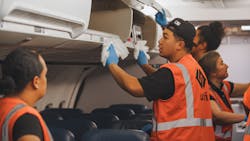Delayed aircraft cost airlines and passengers billions of dollars each year. Airlines for America (A4A) says those costs are in addition to other expenses created by the need for extra gates and ground personnel as well as costs imposed on airline passengers. Altogether, the Federal Aviation Administration’s (FAA) National Center of Excellence for Aviation Operations Research (NEXTOR) estimated the annual costs of delays (direct cost to airlines and passengers, lost demand and indirect costs) in 2018 to be $28 billion.
Throughout 2022 and the start of 2023, airline cancellations and delays were in the news, and airlines were under scrutiny – and, in some cases, under federal investigation.
Of course, cancellations and delays aren’t always in an airline’s control. The Aviation System Performance Metrics (ASPM) online access system records minutes of delay for five possible causes of flight arrival delays: airline carrier, weather, National Aviation System (NAS), security and late arrival. Causes of a cancellation or delay due to circumstances that are considered within the airline's control include aircraft cleaning, baggage loading and fueling.
Ground handlers, including cabin cleaners, play a significant role in helping airlines ensure that a flight leaves on schedule. Josh Kennedy, senior vice president of operations at Unifi, began his career in the industry as a cabin cleaner and has been involved in cabin cleaning in one way or another for about 17 years. Kennedy says following key processes during cabin cleaning is critical in order to get the job done efficiently and effectively.
“Process-wise, time is of the essence,” he says.
“Turnaround cleans definitely require ample manpower to get in there and clean the aircraft,” Kennedy adds.
Baseline teams are made up of four, eight or 12 people. A team of four would be ideal for a regional jet, but teams can get make do with three.
“Everything’s dictated by man minutes, or minutes that are required to clean a plane,” he says. “So if a plane is on the ground for a couple of hours, then obviously you can send less folks from the team up to get the job done.”
Time on the aircraft, based on size of the plane and time available to clean, is determined by the airlines.
If the aircraft is a 737 with normal ground time, Kennedy says eight people would be assigned. If that time was compressed because the flight was arriving late, he says 10 people might be tasked with the turnaround clean. During quick turnarounds on a 737, Kennedy says there is not much room to move, so using more than 10 people could be counterproductive.
“There are set teams so you can kind of plug and play different teams over as they’re dispatched to different aircraft to help out,” he says.
At larger hubs, jobs can be more specialized. Aircraft cabin cleaners will focus only on cabin cleaning. At smaller locations, where an airline might have just a couple of flights per day, multi-tasking is more common. Ground handlers that are loading the bags or gate agents will also assist with cleaning.
“Everyone is kind of all-hands-on-deck in the smallest locations, but at hubs, larger airports, there are definitely dedicated cabin cleaners,” Kennedy says.
Typically, Kennedy says someone who is a cabin cleaner for Unifi will be trained in all areas (galley cleaning, lavatory cleaning, first class seats, coach seats), but there may be a time where an employee only knows one or two of those areas and that is where they will focus.
At the beginning of a shift, employees are assigned to a specific area to clean, and a team leader is designated.
“If the aircraft is on the ground for a minimum ground time – it’s delayed and then you got to allow time for loading and off-loading of passengers, you could be done in 6 to 10 minutes,” he says, adding that’s the shortest timeframe for cabin cleaning to be conducted.
For a normal turn clean, he says 15 to 25 minutes is a normal turnaround clean time on a narrow-body aircraft.
While each airline has different specifics, the overall process is very similar. Post-pandemic, Kennedy says turnarounds still require a more detailed cleaning than what was done in the past prior to COVID. Sanitizing all the touchpoints wasn’t normally done on every turn.
“That was always done on a daily basis for sure, in the past, but now it’s done on every turn,” he says.
Touchpoints include the tray tables, armrests, window shades, air vents, reading light switches, flight attendant call button and the handles on overhead bins.
“Those are all wiped down with a rag and sanitized in a quick fashion,” he says.
When Kennedy is out with the cleaning teams, he tells them that their job is one of the hardest.
“Cabin cleaning doesn’t get the celebration as other areas of aviation does and it’s not easy. It’s a physically demanding job, and that time compression makes it even that much more physical,” he says, adding that’s why it is key to ensure the proper amount of staffing.
Turnaround Cleaning Goals
The goals for turnaround cleans are multiple.
Goal No. 1, Kennedy says, is ensuring that the employees aren’t hurting themselves on the aircraft, which can happen when the proper personal protective equipment (PPE) is not worn.
“Safety is obviously a No. 1 goal for us any time we jump on an aircraft to clean,” he says.
Goals 2 and 3 he says are “making sure that we hit all targets, performing the clean properly as well as in a timely fashion. They go hand in hand.”
If a cabin isn’t cleaned properly, cabin cleaners might be called back to finish the job or address certain areas that were not done properly. That could delay the aircraft another 10 or 20 minutes.
Sometimes more time for a turn clean is necessary.
“When someone has been sick on the aircraft, and you have to bring out the biohazards kits to clean, that would take an additional PPE requirement, getting another kit to bring on board to ensure that we sanitize properly that area, as well as the surrounding areas,” Kennedy says. “When a passenger has been sick on the aircraft, that takes the time out to really, stop, make sure we got everything brought up from a biohazard standpoint and go about the cleaning cautiously from there.
“You have to do it properly. Take the delay. That’s a good delay or good safety time out obviously to make sure it’s cleaned properly.”
Other types of cleaning include overnight cleaning, which is a more detailed process that occurs nightly for an hour or more, and deep cleaning, which occurs every 30 to 45 days and requires six to eight hours.
For turn cleans, specifically, Kennedy offers several tips.
- Before cleaning – Preparation is key to saving time at the beginning of the clean. When you’re not prepared, it can take an extra five minutes-plus to get organized. If you’re cleaning the lavatories, you have a lavatory kit or cleaning bag with all the proper tools. Preparing beforehand wherever chemicals and supplies are necessary is key.
- PPE — Gloves are required 100 percent of the time, regardless of position. Changing gloves or even wearing double gloves may be necessary to ensure the hands are protected. Some cleaners opt to wear masks. It’s not required but gloves are definitely the most important PPE that cabin cleaners use on a per clean basis.
- Training – According to Kennedy, Unifi has a mockup of a cabin with aircraft seats in some markets to assist with training. Getting on aircraft, allowing employees to physically get a feel for the cleaning as they go throughout the process is important because the physical demand of getting in between the different rows can be difficult. Being able to bring on new hires and show videos to new hires who may have never been on an aircraft or flown is key just to get their mind focused on what the job entails. So the training provided by a physical mockup after classroom training is completed helps complement on-the-job training.
- Checklists – Checklists from a lead’s perspective provide oversight on assignments. Flowing through a checklist, and then a separate checklist for a team lead, who then goes through the aircraft to do a final inspection with their checklist, is very helpful.
- Color-codes – Some airlines color-code supplies – one color for galley supplies, one for lavs, one for cabins, etc. From a visibility standpoint, if someone was auditing or someone came on board, they can clearly see that color and ensure that there’s no cross contamination between the different areas, which is very important. Kits are built on an airline’s requirements.
- Ensuring a proper clean – This task falls to team leaders. The leads go through checklists and do a walk through of the aircraft after the team has cleaned.
The Importance of Cabin Cleaners
Kennedy says cabin cleaning staff do not have high visibility or receive recognition from flying customers because the job is done behind the scenes.
“It’s crucial for us as a company and a leadership team to really thank them on a daily basis but more so celebrate wins from audits. The airlines and ourselves, we do internal audits on the teams, and the airlines do audits and really put together a scoring competition between the groups on grading those cleans,” he says. “Celebrating with the teams on those wins to really recognize the folks for the hard work they’ve done is crucial to creating a great culture.”
Kennedy adds it’s important to emphasize how much cleaning tasks matter.
“It’s a thankless job,” he says. “They don’t get to see it, but knowing if that passenger was sitting on an aircraft for three-plus hours in an area that they may not have cleaned and paid lots of money to sit there, they wouldn’t be very happy.
“Passengers want a clean product and our employees carry so much weight of making sure that happens, so it’s a very important job and we have some great folks out there doing it.”
About the Author
Rebecca Kanable
Assistant Editor
Rebecca Kanable, a veteran journalist, worked with Endeavor Business Media's aviation group from 2021 to 2024 as assistant editor of Airport Business, AMT and Ground Support Worldwide. She previously worked for various publications, including trade magazines and newspapers.

